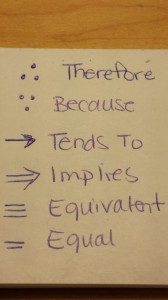I really liked the idea of the partner problem solving for math. I think it is a good way to expose students to different methods of approaching the same question. It also gives students someone to help them interpret the content of a math problem which, at times, can be very difficult, even for high performing students. Given the proper pairings, I also think this activity can be used to get higher achieving, more fluent students to peer mentor students who may be struggling. The mentor can take the position of the listener and help clarify anything that is confusing the solver. Depending on the student, the listener may also be able to model the use of academic language. Afterwards, when the solver explains their solution, they are given an opportunity to use the new language they have learned and also explain how they extracted specific information from the written question.
For many areas in math, being able to read the material is a challenge of its own, especially when the questions are written in math symbols rather than in words. There are many symbols that are very similar in appearance and can be very confusing. Here are a few examples of these similar symbols:
There are times when students understand all of the material and know how to apply what they have learned but are just not able to because they do not understand the symbols or words that are used in the question that is being posed to them. The more students read these symbols and hear them translated, the easier it will be for them to be able to distinguish them and be able to accurately interpret them in the future. As students proceed to higher levels of math this skill becomes increasingly important and therefore needs to be developed as early as possible.

2 replies on “Problem Solving and Translating Math Equations”
In math, understanding what a question is asking is imperative since applying any other knowledge or skills cannot be done appropriately without knowing what is your intent. I agree with your comment of having a solid foundation of reading symbols and terms at an early age can help to ease grasping more complicated concepts in advanced years.
I think the mistake that we often make, especially in the early years, is not treating math as another language that must be broken down into vocabulary words with its many definitions and connotations, syntax, sentence structure, equation formation, etc. Math language is just that, a language, that needs to be taught in similar methods so that it is properly understood and used for communication. While to some extent, it is claimed to be the “universal language”, there are important elements that still require attention and detail to ensure student comprehension.
Ah crap, I left a reply here a long time ago but I guess it never posted.
If you talk to any mathematician, they will tell you that math is a language. It’s a universal language that transcends across geographic languages. Yet, we are often not taught math in the same way as we are taught language. If fact, to be fluent in a language would require almost constant exposure to a language from everywhere; this is clearly not the case with math, so how can we expect our students to be mathematically fluent?
What’s more; math is one of the most information dense types of languages to exist. To be fluent in math requires literacy in numbers, in symbols, in a spoken language like English, and in pictures. It requires students to translate between each of those literacies, sometimes simultaneously.
Another common issue I find when marking math is that students here, have difficulty writing math in any other direction than from left to right. But math can be read in every which direction: left to right, right to left, top to bottom, and bottom to top.
With all these concerns with just the language of math, we still haven’t even touched on understanding concepts in math. But you gotta walk before you can run.